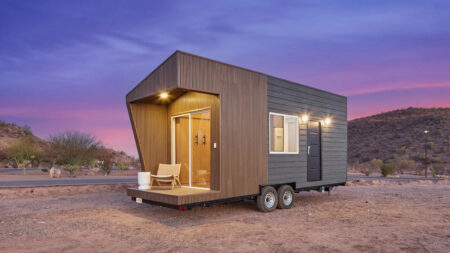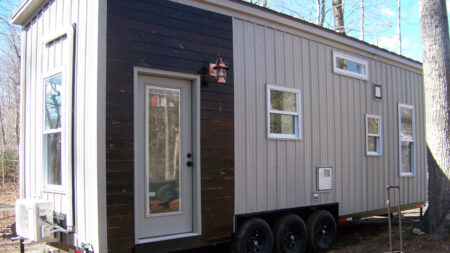2023 was a great year for guys named ‘Travis.’ Travis Scott, the most famous of them started the Utopia-Circus Maximus tour. Travis Barker, the most enthusiastic of them welcomed his first child to the world. Travis Head, the most athletic among the three, scored a ton in the World Test Championship and World Cup Final. And, Travis Pyke, the least known Travis, partnered with THIA (Tiny Home Industry Association) to present the Tellico tiny house to building officials at the International Code Council’s Annual Conference and Expo, to give them an idea about what functions and quality a tiny house on wheels offers.
Pyke may not be as renowned, but his presence in the economic context is more important than any of the above individuals. The sole reason behind this is, him being the CEO of the most acknowledged tiny house company in the world, Wind River Tiny Homes.

Nestled in the rugged beauty of Northwestern Wyoming, Wind River Tiny Homes is a name that echoes through the tiny home community. It is a name that resonates with simplicity and natural beauty. It is a name that draws its inspiration from the remote Wind River Range. It is a name that has over the years become synonymous with success. “How did you conceive a name like that for a micro dwelling design and manufacturing company?”, I asked Travis.
“Our family grew up backpacking, fishing, and climbing, and Wind River Range was one of our destination vacations since I was five years old. I think I’ve been there 15 times. So when I started the company, I was trying to come up with a clever name that had to be in the construction realm and trying to tie it into what tiny homes were. I just wanted to keep it simple with Wind and River. So it kind of struck. I didn’t even know if it was going to be long-term. It was just I needed a name to register the company, and now we just kind of go by Wind River,” Travis Pyke, CEO of Wind River Tiny Homes reveals.
Today, when the housing affordability crisis is growing across the world, and mobile habitats are getting more attention, Travis Pyke and his company aim to make the most of the moment by offering affordable tiny homes on wheels. In the hands of Pyke, Wind River Tiny Homes has unveiled several 45-foot Park Models and a score of Signature homes. The recent of these is the globally-launched Tellico tiny house, which he exhibited to officials, as a new standard process for movable tiny homes.

Pyke’s journey into the world of tiny home construction however started with his lifelong passion for craftsmanship. Starting with homeschooling in seventh grade, where he actively participated in building the family’s log cabin, Travis developed a profound appreciation for architecture and design. The turning point however occurred in 2012, when he encountered an article about the Tumbleweed Tiny House company.
Seeing it as an opportunity to combine his diverse construction skills, he took the plunge. “I saw the tiny home by Tumbleweed and was like, that’s something that I could easily do. I had the skill of doing all sorts of different things in construction, so I bought a trailer the next week and started building a tiny house. I spent about a year and a half, just evenings and weekends when I wasn’t doing my other job and I think I built it for about 16K-18K.”
“I was very scrappy, held it all together, and then did all the labor myself. So that’s the Wind River bungalow that you can see on our site, our first kind of legacy build. I got engaged halfway through, and so we moved into it right after we got married and lived in it for four years, and then a friend wanted one and somebody else wanted one. And that’s when we started the company in 2014,” Travis informs.

“Travis, there’s often a cloud of confusion surrounding distinctions between a tiny house on wheels and a park model, Could you provide more clarity into the matter”, I questioned him. To which he answered, “Most simply they’re not different. I guess what would be different is all of our homes are park model tiny homes.”
To elucidate the statement, he further informed, “Several years ago, most tiny home builders started realizing they needed to get that third party certification, so they’re essentially RVs at the end of the day. The classification that they fall into is a park model recreational vehicle. There’s a third party that comes in and reviews your facility and certifies your facility. The only difference I would say is if you’re a tiny home builder and you’re not getting your home certified by a third party, you shouldn’t use Park Model in your branding or marketing or your name because that means it’s certified to the ANSI code. So at the end of the day, ‘Park Model’ and ‘Tiny Home’ are pretty much the same thing as far as size is concerned. Some people build cheap ones and then others build really nice ones. So that’s kind of the difference.”

With Travis at the helm, the company has also experienced significant growth and expansion, tripling production since 2019. In 2023, they began construction of a 92,000-square-foot manufacturing facility in Cleveland, Tennessee, which will open in April 2024. With this expansion, Wind River will not only increase build capacity to meet demand, but also expand into the offsite construction of single-family and multifamily modular homes.
Travis explains that Wind River Tiny Homes has evolved over the years to meet the diverse needs of homeowners. While the company still offers the compact 24-foot models, larger options and ADUs have become increasingly popular. “Tellico and Pisgah are kind of probably the last tiny homes that we’ve developed and then now we’re kind of focusing on modular. We are going to release some ADU models early next year, so they’ll be modular, not on a trailer frame, in three different sizes, and we’re targeting Nashville, Chattanooga, and Atlanta, as a lot of residential code allows you to put an accessory dwelling unit in your backyard to rent out or in-laws can live there. So we’re, going to develop three models and kind of roll those out. Beyond that, we’re hoping for bigger contracts like development communities, and cottage clusters.”
The discussion veered into the dynamics of the tiny home movement and the surge in popularity of park model homes. “In the last 10 years with the economic climate and the generation, the boomers have their big homes that are probably paid off. Their goal was to sell those things and move on to their retirement home. Then we have Gen Z and millennials who are more traveling people. Also, the family size is getting smaller. All of these people want more of an experiential lifestyle, so there is certainly more demand for tiny homes. People want to live in something easier to maintain.”
In a strategic move, Wind River Tiny Homes is now rebranding as Wind River Built, with distinct product lines, which are Wind River Tiny Homes and Wind River Modular. The expansion aims to address the challenges faced by those drawn to tiny living, providing an accessible and sustainable home to those in need.
Follow Homecrux on Google News!




